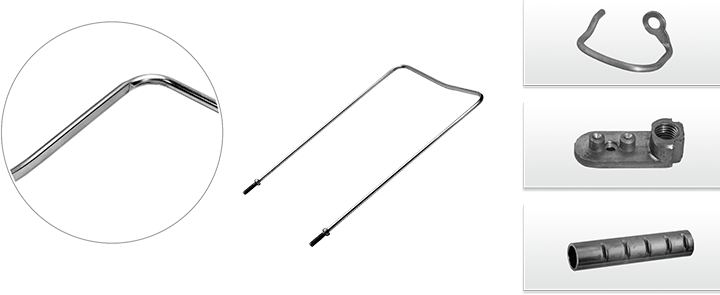| Stage I | Stage II+III | Stage IV |


| Stage V | Stage VI |
Diameter 1/4“, 2.4 sec cycle time, 25 pcs./min., flattening at 360,000lbs, part family with several different length, finished part falling out, power requirement approx. 20 kW
Threading with collar swaging and flattening
In the metal processing industry, there are different forming processes that are used to create a wide variety of metal parts. Among the many forming processes, we can find threading, swaging and flattening.
Threading
As the name suggests, threading is the process used to create threads such as on screws and nuts, or any other kind of metal part that requires a thread for its proper operation. There are different methods to create a thread depending on the shape and material of the part, operational conditions and desired results.
The most common threading methods are cutting, milling, and rolling, with each of them having different ways to perform it.
Swaging
Swaging is another forming process commonly used for wires, pipes and strips to change the dimensions of the profile by forcing them into dies as a cold or hot working process. Again, different methods are used, including extrusion through a die and the use of two or more rotary dies from the outside, both to reduce diameter of a section or the entire part.
A common application of this process is creating collars on bars or wires with a round section, also known as collar swaging. Collars are used to provide locking power to a non-threaded part such as a bolt or to increase the locking power of threaded ones.
More complex applications of swaging include axles, drive shafts, transmission shafts, steering rods, among others.
Flattening
This forming process is usually applied to alter cross sections from round to a flat profile which is sometimes required to meet specific requirements and to comply with tight tolerances. A common use for flattening is to provide the possibility of joining a part with a round section (like a bar) to a flat part (like a sheet metal part) by means of screws or bolts. The bar or wire is flattened at the ends to create a hole that will allow for the joint to be possible.
Schmale threading with collar swaging and flattening
By combining these three processes, the most complex parts with different cross sections can be achieved to cover the most demanding requirements and specifications. However, if done in a traditional way, the production costs of such parts would be extremely high, as each process will require specific tools and workforce to be completed, adding up to the total costs. Moreover, the manufacturing flow will depend on the movement of the part from one step to the other, thus reducing efficiency and time to market, which in turn means a lower competitiveness.
Schmale technologies provide a fully automated tool set to avoid negative impact from combining the three methods to achieve a threading with collar swaging and flattening on any part. The tool consists of 5 stages that complete a 3 second cycle for each finished part. At stage 1 the wire is fed from the coil via servo electric roll feeder. Stage 2 and 3 include a two-die rolling threading and two-die collar swaging, to later be flattened and bent (according to requirements) at stages 4 and 5.
For a better view of the stages of the process, please refer to the pictures. If you have any questions, please do not hesitate to contact us and we will gladly help you.
